2 Non-Carbon Emitting Energies
Jack Harris
2.1 Introduction
Keywords
- Renewable – a renewable resource can be replaced after it is used and is collected on a human timescale
- Wind power – A source of energy collected when wind moves turbines that power electric generators
- Solar power – a source of energy collected by using the light and heat of the sun
- Nuclear fission – energy derived from the splitting of atoms harnessed to create electricity
- Uranium – the element most commonly used for nuclear fission
- Turbine – a machine for producing continuous power in which a wheel or rotor, typically fitted with vanes, is made to revolve by a fast-moving flow of water, steam, gas, air, or fluid.
- Generator – a dynamo or similar machine for converting mechanical energy into electricity.
- Electricity grid – an interconnected network for electricity delivery from producers to consumers.
- Carbon emissions – the most common form is carbon dioxide or CO2. Most of the carbon dioxide output on Earth is as a result of human activities like deforestation, cement production, and the burning of coal, oil, and natural gas.
- Intermittent energy – not available consistently due to outside conditions
- Baseline energy – can be turned into usable energy a majority of the time because within a closed operation
Learning Objectives
By the end of this chapter, students should be able to:
- Have a basic understanding of wind power, solar power, and nuclear power
- Understand the impact of non-carbon producing energies
- Discuss how climate change has an impact on the energies we use
- Make a claim about where energy is going in the future
Throughout this chapter, we will explore energy sources that do not produce carbon emissions. Renewable energy comes from a resource that can be replaced after it is used and collected on a human timescale. Examples of renewable energy include wind power and solar power. Nuclear power is an example of nonrenewable energy. Despite it being nonrenewable, nuclear power does not produce carbon emissions, the leading cause of climate change. In total, each of these combines to make up a part of the energy system that is currently being used in the United States.
The other part of the energy system is primarily carbon-producing energies like coal, natural gas, and petroleum. These forms of energy are some of the leading causes of climate change, a global issue with far-reaching implications. In the next 30 years, we must transition away from carbon-producing forms of energy to sustain the same quality of life as is present. In the overall discussion of science and technology in society, non-carbon emitting energy is essential because it provides a way to combat climate.
2.2 Types of Non-carbon Emitting Energies
Key Takeaway
Wind, solar, and nuclear energy do not produce carbon, the main force behind climate change. Each has its own advantages and disadvantages.
This section will be devoted to the different forms of energy that do not produce carbon emissions. The first of these is wind energy. It does not produce carbon because it is a renewable resource because it only uses naturally occurring wind to power it. The second is solar energy which is powered by the sun. These two can be called intermittent sources of energy because the wind does not always blow consistently, and the sun only shines enough to be collected part of the time. The final form of energy we will discuss is nuclear power. Nuclear power harnesses the energy that comes from breaking apart the nucleus of an atom. Nuclear is considered baseline energy because nuclear power plants can be operated close to 90% of the time.
2.2.1 Wind Power
Key Takeaway
Wind power creates electricity by turning turbines to power a generator.
Wind power has been used for thousands of years as a means of generating energy. Many of the first uses of wind power were to help process grain, other foods, or even pump water. In the United States, wind power was used in the colonies and saw increased use in the 1980s due to an oil shortage. Research efforts were funded by the government and vastly increased the number of turbines in use.
In the 1990s, the United States issued a tax credit for wind power which greatly incentivized the building of wind turbines. Fueled by an increase in demand for renewable energy and greater investment into wind energy, the price of wind energy decreases dramatically.
In 2020, wind energy accounted for 8.4% of US electricity generation, compared to less than 1% in 1990(EIA).
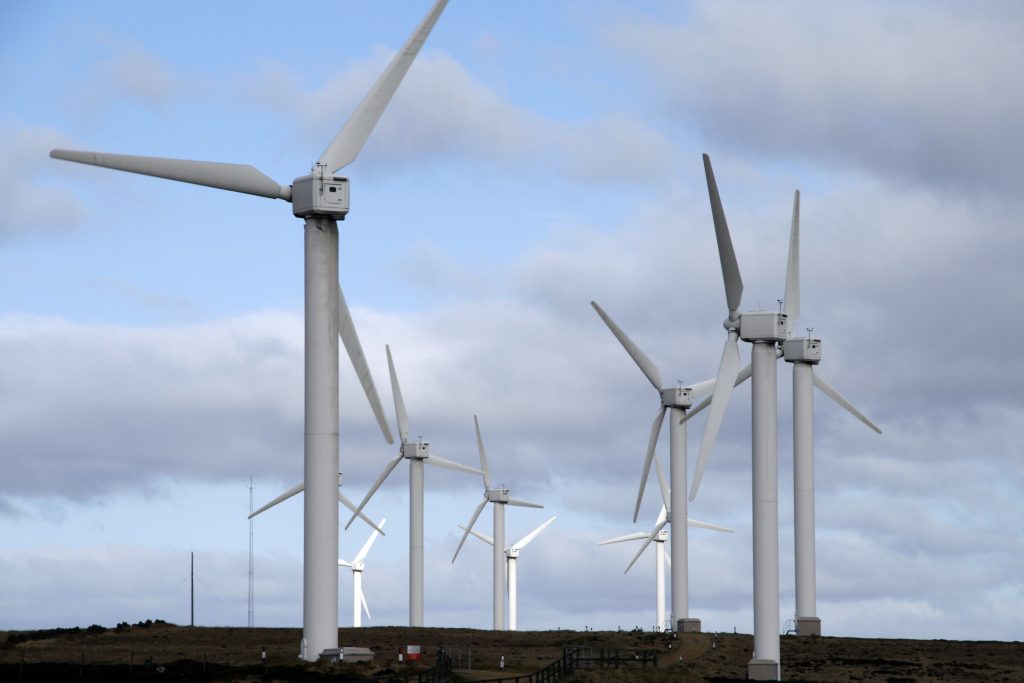
“Wind Turbines” by K Ali is licensed under CC BY-NC-SA 2.0
2.2.2 Solar Power
Key Takeaway
Solar power has been used since the beginning of mankind to grow plants and nourish the human body. Yet, solar power for the purpose of creating electricity is relatively new. Solar power has a variety of uses and a variety of ways it can be collected. Some of its uses are for creating electricity, light, or heating water. Some of the ways it can be collected are through solar panels, solar water heaters, and even molten salt power.
The way in which solar power is used that you might be most familiar with is solar panels. They work by creating an electric current when sunlight hits them and harnessing that electricity. Solar panels can vary in size from just a few square centimeters to a few square meters.
Solar panels can be used on smaller scales too. Homeowners can use solar panels so that they do not have to pay electricity bills. Cities can use solar panels to decrease the amount of energy they need.

“Rows of solar panel at a thermo-solar power plant” by World Bank Photo Collection is licensed under CC BY-NC-ND 2.0
2.2.3 Nuclear Power
Key Takeaway
Nuclear fission works by harnessing the power of the nucleus of an atom to create energy.
There are two main types of nuclear fission reactors used in the United States currently. One is a pressurized water reactor that pumps water into the reactor core at high pressure which keeps the water from boiling. Once the water is heated, it produces steam that powers an electric generator. The other is a boiling water reactor. The boiling reactor works by allowing the water to boil using the steam produced by the nuclear fission process. The steam powers a turbine that produces electricity. The steam is then converted back to water in the liquid state and reused.
Nuclear power has undergone much scrutiny since the fallout of a reactor in Chernobyl, Ukraine. The reactor there caused 27 lives to be lost within a year of the accident and many more cases of cancer. Additionally, the area will be radioactive for many thousands of years, and neither wildlife nor humans can inhabit it during that time. For the same reason, there is much controversy surrounding the storing of radioactive materials used to power nuclear reactors. Since they will be toxic for thousands of years, they must be stored responsibly or risk harm to the environment and people.
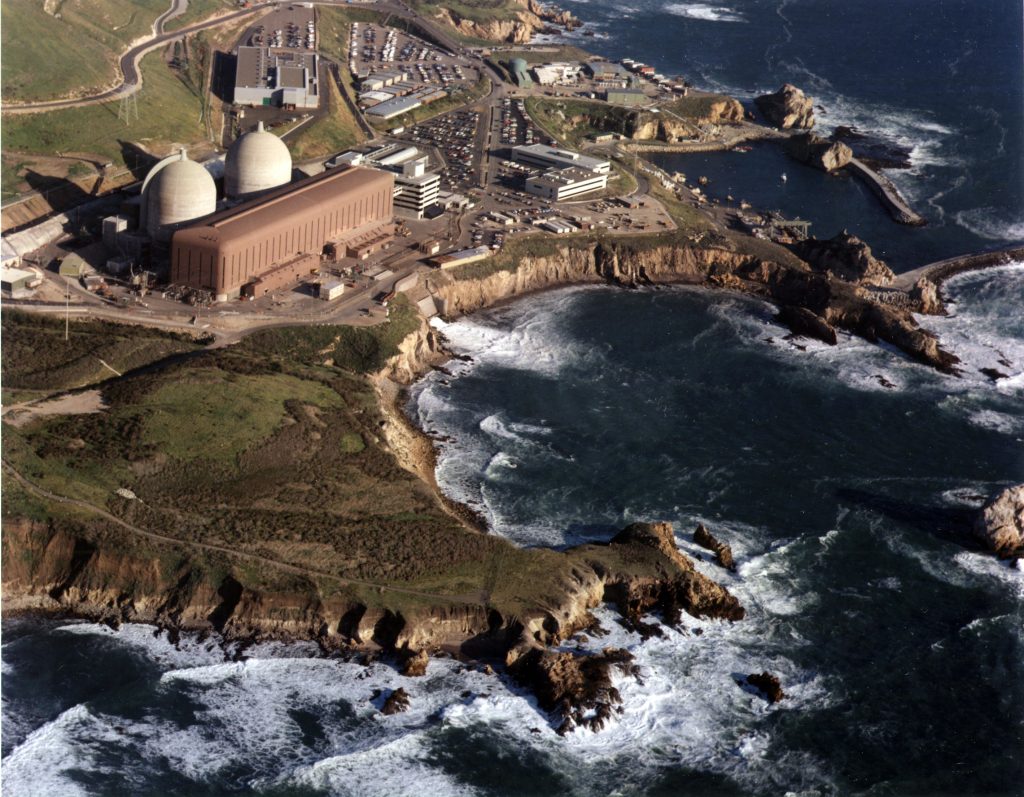
“Diablo Canyon Nuclear Power Plant, Units 1 and 2” by Nuclear Regulatory Commission is licensed under CC BY-NC-ND 2.0
2.3 The prevalence of renewable energy today
Key Takeaway
As you learned in the last chapter, coal and natural gas are two other ways to create electricity. However, when they are produced, carbon dioxide is released into the atmosphere. Carbon dioxide is a greenhouse gas which means it can cause heating of Earth’s temperatures, known as The Greenhouse Effect. At the pace of climate change currently, if humans continue to create this much carbon dioxide, the world as we know it will be completely different.
One of the ways that our world could change is the melting of the polar ice caps. Polar ice caps are home to much of Earth’s freshwater supply, and if they melt, it could lead to rising sea levels. This is predicted to cost hundreds of billions in damage. Animals may go extinct as their habitats will be inhospitable.
As a response to climate change and energy sources that produce lots of carbon like coal and natural gas, renewable energies like solar and wind have been invested in as well as nuclear energy which is not considered renewable but does not create carbon.

“Melting polar ice caps, Arctic Circle. Courtesy Creative Commons” by Royal Opera House Covent Garden is licensed under CC BY 2.0
2.4 Current energy uses
Key Takeaway
Currently, the breakdown of energy sources in the United States relies heavily on petroleum and natural gas. These are nonrenewable energy sources that are mainly used for transportation, manufacturing, electricity, and heating. The percentages of United States energy consumption for petroleum and natural gases are 34.7% and 33.9%, respectively. Following far behind is coal at 9.9% of United States energy consumption. Coal is also a nonrenewable energy source that is used for electricity and manufacturing. Next is nuclear energy from uranium. At 8.9% of overall energy consumption, this nonrenewable energy source is for electricity generation. It is unfortunate that the majority of United States energy consumption is made of nonrenewable sources. Such a small percentage of the energy consumption is through renewable sources like wind and solar. Wind accounts for 3.2% of energy consumption and contributes directly to electricity. At the same time, solar energy is about 1.3% of United States energy consumption used for electricity as well as heating(EIA). Overall, these renewable energy sources make up a small portion of United States energy consumption. This proportion needs to drastically change to slow the effects of climate change over the next ten years.
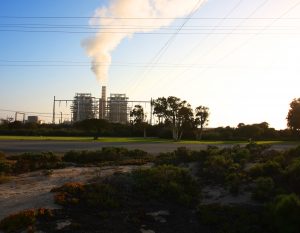
“Coal-fired Power Plant” by Rennett Stowe is licensed under CC BY 2.0
2.4.1 Disadvantages of non-carbon emitting technologies
Key Takeaway
The auto industry is worth 2 trillion dollars in the United States. The government, companies, and special interests all have financial and social to keep it this way. However, the amount of carbon emissions emitted by the entire industry is astounding. This is because of the sheer amount of energy required to power all of the manufacturing and daily operation of cars run by gasoline. Since renewable energies like wind and solar do not provide baseline energy, they have not been utilized as sources of energy for cars. Neither has nuclear since the heat it creates provides electric energy. Until cars are mostly electric, carbon-producing forms of energy will be the default for the giant auto industry.
However, the United States has said that it has a goal of 50% of the sales of new cars to be electric. Companies like Tesla are well suited for this change because all of their cars are electric. Companies like Ford and GM are having to pivot away from their traditional cars into electric vehicles but are making pushes to get to the government’s number before 2030. It will be interesting to see how this change affects the impact of climate change.
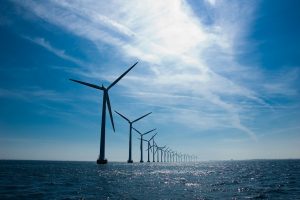
“Windmills at the windmill farm Middelgrunden” by andjohan is licensed under CC BY-SA 2.0
2.5 Environmental impact
Key Takeaway
Wealthy countries are responsible for the majority of climate change. The carbon emissions produced by those countries far outweigh that of poorer countries. However, the poorest countries are paying the highest price in terms of feeling the effects of climate change.
Some estimates say that rising sea levels will affect 23 trillion dollars of industry by 2050 (Swiss Re Institute). The hardest-hit countries will be poorer countries mostly in South Asia. Countries like the United States and Canada, two of the highest contributors to carbon emissions per capita, are two of the countries least likely to be affected by climate change. Part of this is simply location. However, poorer countries also do not have the resources to protect themselves from the rising sea levels as well as changes in weather patterns. Droughts, periods of heavy rainfall, and hurricane patterns are all going to change as a result of a global increase in temperature.
Energy sources like wind, solar, and nuclear do not produce carbon. Thus, turning to cleaner forms of energy is a way to slow the climate crisis. Yet, it is not all of the battle. Countries must be proactive and act together if they want to slow climate change. The United Nations plays a large role in making this happen. The Paris Climate Agreement was facilitated by the United Nations in 2015 and presents a way toward negating the effects of climate change. However, not all the member countries have been loyal to what they signed, and larger countries that left themselves off make a large impact that cannot be negated by a few countries. Bridging this gap is crucial to seeing real change.
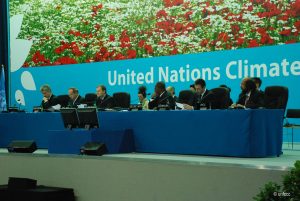
“United Nations Climate Change Conference” by UNclimatechangeis licensed under CC BY-NC 2.0
Case Study: Solar Changing Lives
In Kenya, Winifred Mumbua Muisyo has just received access to electricity for the first time in her life. This is because there is no electricity grid in the place where she lives. The solar panel installation she got is now popular in Kenya because of tax credits that were received. It is an affordable addition costing around $5 per month which is about the same as kerosene for lamps.
By gaining access to electricity, her family can watch television, her sons can do homework after the sun sets, and Winifred can investigate noises outside after dark. For someone who has never been able to see after dark, this allows her access to more hours in the day (Sommer, 2021).
Chapter Summary
Throughout this chapter, we explored energy sources that do not produce carbon emissions. We learned about wind, solar, and nuclear power and how they work. We learned why nonrenewable energy is used more abundantly than renewable energies. Additionally, we learned about the effects of climate change on the world and how moving toward energy sources that do not produce carbon can help remedy the climate crisis. This chapter is important to the study of science and technology in society because the energy uses that we use currently have an impact on the way we live our lives currently as well as how we will continue to live them in the future.
- Select the carbon-producing form of energy
A. Solar
B. Nuclear
C. Wind
D. Hydro
- Does the United States use carbon-producing or non-carbon-producing forms of energy more?
A. Carbon-producing
B. Non-carbon-producing
- Which of the following can be installed in poorer countries to establish electricity easiest?
A. Hydro
B. Nuclear
C. Wind
D. Solar
- True or false: One country can solve climate change themselves
A. True
B. False
Answers:
- B
- A
- D
- B
Food for Thought
- In what ways will the next 20 years be shaped by changing energy needs?
- How do energy sources affect climate change?
- If you were a politician what form of energy would you support? Why?
- Consider how energy needs and accessibility change by location? What is the best form of energy for your hometown?
References
Frequently asked questions (faqs) – U.S. energy information administration (EIA). Frequently Asked Questions (FAQs) – U.S. Energy Information Administration (EIA). (n.d.). Retrieved November 18, 2021, from https://www.eia.gov/tools/faqs/faq.php?id=427&t=3.
National Renewable Energy Laboratory (NREL) home page | NREL. (n.d.). Retrieved November 18, 2021, from https://www.nrel.gov/docs/fy20osti/75284.pdf.
Nuclear 101: How does a nuclear reactor work? Energy.gov. (n.d.). Retrieved November 23, 2021, from https://www.energy.gov/ne/articles/nuclear-101-how-does-nuclear-reactor-work.
Part 2 energy conversion technology – JSTOR. (n.d.). Retrieved November 18, 2021, from https://www.jstor.org/stable/j.ctt6wq56p.9.
Renewables: Energy you can count on solar … – jstor.org. (n.d.). Retrieved November 18, 2021, from https://www.jstor.org/stable/resrep00012.
Richard Rhodes is the author of numerous books, Rhodes →, M. about R., Mendelsohn, R., Mendelsohn, R., Pearce, F., & Pearce, F. (n.d.). Why nuclear power must be part of the Energy Solution. Yale E360. Retrieved November 18, 2021, from https://e360.yale.edu/features/why-nuclear-power-must-be-part-of-the-energy-solution-enVironmentalists-climate.
Sommer, L. (2021, November 10). This Kenyan family got solar power. high-level climate talks determine who else will. NPR. Retrieved November 23, 2021, from https://www.npr.org/sections/goatsandsoda/2021/11/10/1052926511/this-kenyan-family-got-solar-power-high-level-climate-talks-determine-who-else-w.
Swiss Re Institute. (n.d.). April 2021 the economics of climate change. Retrieved November 23, 2021, from https://www.swissre.com/dam/jcr:e73ee7c3-7f83-4c17-a2b8-8ef23a8d3312/swiss-re-institute-expertise-publication-economics-of-climate-change.pdf.
The need for a new, clear option: An in-depth … – JSTOR. (n.d.). Retrieved November 18, 2021, from https://www.jstor.org/stable/26427280.
Tough love for renewable energy: Making wind … – jstor.org. (n.d.). Retrieved November 18, 2021, from https://www.jstor.org/stable/23217972.
U.S. Energy Information Administration – EIA – independent statistics and analysis. History of wind power – U.S. Energy Information Administration (EIA). (n.d.). Retrieved November 18, 2021, from https://www.eia.gov/energyexplained/wind/history-of-wind-power.php.
The most common form is carbon dioxide or CO2. Most of the carbon dioxide output on Earth is as a result of human activities like deforestation, cement production, and the burning of coal, oil, and natural gas.
A renewable resource can be replaced after it is used and is collected on a human timescale.
Not available consistently due to outside conditions.
Can be turned into usable energy a majority of the time because within a closed operation.
A source of energy collected when wind moves turbines that power electric generators.
A machine for producing continuous power in which a wheel or rotor, typically fitted with vanes, is made to revolve by a fast-moving flow of water, steam, gas, air, or fluid.
A dynamo or similar machine for converting mechanical energy into electricity.
A source of energy collected by using the light and heat of the sun.
Energy derived from the splitting of atoms harnessed to create electricity.
The element most commonly used for nuclear fission.

